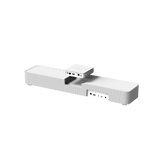A Generational Leap: An Expert Deep Dive into Amlogic's S905X5 vs. S905X4

Amlogic S905X5 SoC: What It Means for Home Theater & Homatics
Why the S905X5 is a meaningful upgrade over the S905X4—AV1 hardware decode, on-chip AI upscaling, and better perf/watt—and how Homatics will use these gains to improve home theater and surround sound experiences.
Introduction
In the intricate ecosystem of smart home entertainment, the System-on-Chip (SoC) is the heart that dictates performance, capability, and the overall user experience. Among the key architects of this landscape, Amlogic has established itself as a dominant force, its silicon powering a vast and diverse range of Android TV boxes, streaming dongles, and smart television sets across the globe. For years, the Amlogic S905X4 has been the celebrated incumbent—a highly successful, widely adopted SoC from the 2019-2020 era that brought reliable 4K performance and, critically, mainstream hardware support for the efficient AV1 video codec to the masses. It represents the mature pinnacle of its architectural generation, a workhorse that has defined the 4K streaming experience for millions.
Entering this established market is its successor, the Amlogic S905X5. This is not a mere iterative refresh or a simple die shrink. The S905X5 represents a fundamental paradigm shift, a true next-generation SoC engineered from the ground up on a new CPU microarchitecture and a cutting-edge manufacturing process. It promises not just an incremental increase in speed but a revolutionary leap in raw performance, power efficiency, and, most importantly, intelligent, AI-driven features that aim to redefine visual fidelity.
Table 1: At-a-Glance Specification Comparison
To frame the detailed analysis that follows, this table provides a high-level, scannable summary of the core technical differences between the Amlogic S905X4 and the flagship S905X5. It serves as a quick-reference guide to the key battlegrounds—architecture, manufacturing process, AI capabilities, and codec support—that define this generational leap.
| Parameter | Amlogic S905X4 | Amlogic S905X5 |
|---|---|---|
| CPU Microarchitecture | Quad-core ARM Cortex-A55 (ARMv8.2-A) | Quad-core ARM Cortex-A510 (ARMv9-A) |
| Manufacturing Process | 12 nm | 6 nm |
| GPU Architecture | ARM Mali-G31 MP2 (Bifrost) | ARM Mali-G310 V5 (Valhall) |
| NPU (AI Accelerator) | None (Optional on S905X3, not standard) | 3.2-4 TOPS NPU with AI-SR |
| Max Memory Support | 4 GB LPDDR4 | 8 GB LPDDR5 |
| Key Video Codec Support | AV1, H.265, VP9 (4K@60fps) | H.266/VVC, AV1 (4K@120fps), H.265 |
| Advanced HDMI 2.1 Features | Basic (Dynamic HDR, ALLM) | HDMI 2.1b (VRR, QMS, ALLM, eARC) |
Section 1: The Architectural Divide: A Generational Shift in Silicon
The distinction between the S905X5 and its predecessor is not a simple matter of higher clock speeds; it is a fundamental divergence in the very blueprint of the silicon. This section analyzes the foundational, architectural changes in the CPU, manufacturing process, and GPU that collectively define the S905X5's technological superiority.
1.1 CPU Microarchitecture: From ARMv8's Cortex-A55 to ARMv9's Cortex-A510
The Central Processing Unit (CPU) is the brain of the SoC, and the S905X4 is built upon a proven and highly capable one: a quad-core cluster of ARM Cortex-A55 cores, based on the ARMv8.2-A instruction set and clocked at up to 2.0 GHz. This design was a significant step up from the older Cortex-A53 cores found in previous generations, offering a notable improvement in performance and power efficiency for day-to-day tasks like navigating the user interface and running Android applications.
The Amlogic S905X5 executes a monumental leap forward, abandoning the ARMv8 architecture entirely. It is built around a quad-core cluster of ARM Cortex-A510 cores, the first generation of ARM's "efficiency" cores based on the next-generation ARMv9-A instruction set. This transition is the single most important architectural upgrade in the entire SoC. The significance of ARMv9 extends far beyond a simple increase in raw processing power. It introduces a suite of platform-level enhancements that have profound implications for the device's security and capabilities.
First, ARMv9 was designed with a security-first approach, integrating features like the ARM Confidential Compute Architecture and enhanced TrustZone capabilities directly into the hardware. For a media streaming device that handles premium, DRM-protected content and user data, this provides a more robust and secure foundation against potential threats. Second, the Cortex-A510 cores deliver a substantial uplift in Instructions Per Clock (IPC) compared to the Cortex-A55, meaning they can perform more work in each clock cycle, leading to greater overall performance and efficiency. Finally, and perhaps most critically for a modern media SoC, the ARMv9 architecture includes specific optimizations for Artificial Intelligence (AI) and Machine Learning (ML) workloads. This is not a coincidental upgrade; it is a necessary and symbiotic evolution. The CPU's enhanced ability to handle AI-related instructions provides a more efficient foundation for the S905X5's powerful Neural Processing Unit (NPU) to operate, ensuring that AI-driven features run smoothly without bogging down the main processor. The CPU upgrade is therefore not just an isolated performance bump; it is a causal enabler for the very intelligent features that define the S905X5.
1.2 Manufacturing Process: The Power and Thermal Efficiency of 6nm
The Amlogic S905X4 is fabricated on a 12 nm lithography process. While highly effective and a significant improvement over the 28 nm processes of older chips, this node represents a technology that is now several generations behind the cutting edge. In contrast, the Amlogic S905X5 makes a dramatic leap to a modern 6 nm manufacturing process.
The physics behind this advancement are straightforward but have critical real-world consequences. A smaller process node means the transistors—the fundamental building blocks of the chip—are smaller and packed more densely. This reduced distance between components results in lower electrical resistance and less power leakage, meaning the chip can perform the same amount of computational work while consuming significantly less power and generating substantially less heat. The S905X5's remarkably low Thermal Design Power (TDP) of just 5W is a direct testament to this efficiency.
For the end-user, this translates into a tangibly better experience, especially within the compact, passively cooled chassis of a typical Homatics streaming device where heat dissipation is a primary engineering challenge. A 12 nm chip under sustained load, such as during a long 4K movie playback or a gaming session, will generate more heat and may be forced to engage in thermal throttling—a self-preservation mechanism where the SoC reduces its clock speed to cool down, resulting in stuttering, a sluggish user interface, and overall degraded performance. The 6 nm S905X5, by its very nature, is more thermally efficient. It can sustain its peak performance clocks for much longer periods without throttling, ensuring a consistently smooth and responsive experience, greater device longevity, and superior reliability over extended use.
1.3 GPU Evolution: Mali-G31 MP2 vs. Mali-G310 V5 for a 4K UI
The Graphics Processing Unit (GPU) is responsible for rendering everything seen on screen, from the user interface to video playback and gaming. The S905X4 employs the ARM Mali-G31 MP2, a capable GPU based on the Bifrost architecture, typically clocked around 850 MHz. While perfectly adequate for decoding and outputting 4K video, this GPU can sometimes be a bottleneck when tasked with rendering a complex, modern user interface (like Google TV) at a native 4K resolution, which can lead to occasional dropped frames or a less-than-perfectly-fluid feel.
The S905X5 introduces the ARM Mali-G310 V5, the first GPU in its class to be based on ARM's newer and more efficient Valhall architecture. This new GPU is not only based on a superior architecture but is also clocked significantly higher at 1000 MHz. The performance uplift is staggering. A key metric for graphical horsepower is floating-point performance, measured in GFLOPS (Giga-Floating-point Operations Per Second). The S905X4's Mali-G31 MP2 delivers a respectable 20.8 GFLOPS. The S905X5's Mali-G310 V5 more than doubles this, achieving 52 GFLOPS.
This massive increase in raw graphical power is not merely for improving gaming performance, though it certainly helps. Its primary purpose is to address a long-standing weakness in the Android TV ecosystem: the user interface. Amlogic has explicitly targeted a "4K GUI" with this generation, and the Mali-G310 V5 provides the necessary horsepower to render a silky-smooth, high-framerate user interface at native 4K resolution. This directly improves the perceived quality, fluidity, and premium feel of the entire device. Furthermore, the S905X5's GPU adds support for the newer Vulkan 1.2 graphics API, providing better performance in modern applications and making the platform more attractive to developers, thus enhancing its future-proofing.
Section 2: The Performance Verdict: Benchmarks and Real-World Speed
While architectural analysis reveals the theoretical advantages of the S905X5, synthetic benchmarks provide the quantitative data needed to measure the real-world performance gap. This section translates the silicon-level improvements into hard numbers, demonstrating a performance delta that is nothing short of generational.
2.1 Synthetic Benchmark Deep Dive
A consolidated look at results from several industry-standard benchmark suites reveals the S905X5's commanding lead across the board.
- PassMark: This benchmark provides one of the most direct and dramatic comparisons of raw CPU capability. In aggregated results from the PerformanceTest suite, the Amlogic S905X5 achieves an average CPU Mark of 1,699. In the same test, the Amlogic S905X4 scores a mere 500. This represents a staggering 239.8% increase in overall CPU performance. The advantage holds in single-threaded performance, which is a critical indicator of user interface responsiveness and snappiness in everyday tasks. The S905X5 scores a Single Thread Rating of 967, while the S905X4 trails with 506, a lead of over 91% for the newer chip.
- AnTuTu: This is a holistic benchmark that tests CPU, GPU, memory, and user experience (UX) performance. While direct comparisons can be influenced by firmware and device optimization, the available data points to a massive leap. The S905X5-based Ugoos AM9 device posted a score of 272,468 in AnTuTu v9/v10. For context, devices based on the S905X4's direct predecessor, the S905X3, typically scored in the 100,000-110,000 range, indicating that the S905X5 platform offers more than double the overall system performance.
- Geekbench: In Geekbench 5, a device powered by the S905X4 registered a single-core score of 159 and a multi-core score of 543. While a comparable public Geekbench 5 score for a retail S905X5 device is not yet widely available, the nearly 2x improvement in PassMark's single-thread rating strongly suggests the S905X5 will post significantly higher scores in this test as well.
- 3DMark: To gauge graphics performance, early data is highly promising. Even the cost-reduced S905X5M variant has been shown to be between 1.36 and 2.8 times faster in 3DMark and GFXBench tests than the S905X4-J. Given that the flagship S905X5 features a higher-clocked GPU based on a more advanced architecture, its lead over the standard S905X4 in graphics-intensive tasks is expected to be even more substantial.
2.2 Deconstructing Processing Power: The DMIPS Metric
Beyond holistic benchmarks, the DMIPS (Dhrystone Million Instructions Per Second) metric offers a pure measure of a CPU's integer-processing capability—its ability to crunch raw instructions. This metric strips away variables like memory speed and GPU performance to focus on the core computational engine. Here again, the architectural superiority of the Cortex-A510 cores is laid bare. The Amlogic S905X4 is rated with a respectable processing power of 21,800 DMIPS. The Amlogic S905X5 nearly doubles this figure, boasting a massive 40,000+ DMIPS. This near-100% increase in instruction throughput is a direct consequence of the more advanced ARMv9 architecture and the higher IPC of its Cortex-A510 cores.
Table 2: Consolidated Benchmark Performance
This table consolidates the key performance metrics, providing a clear, data-driven visualization of the performance chasm between the two SoCs. The "Performance Uplift" column quantifies the S905X5's advantage in percentage terms, highlighting the magnitude of its lead.
| Benchmark | Amlogic S905X4 | Amlogic S905X5 | Performance Uplift % |
|---|---|---|---|
| PassMark CPU Mark | 500 | 1,699 | 2.398 |
| PassMark Single Thread | 506 | 967 | 0.911 |
| DMIPS | 21,800 | 40,000+ | 0.835 |
| AnTuTu v9/v10 (Rep. Score) | ~110,000 (est. based on S905X3) | 272,468 | 1.477 |
| GPU FP32 Performance | 20.8 GFLOPS | 52 GFLOPS | 1.5 |
Data compiled from sources:. AnTuTu for S905X4 is an estimation based on its predecessor's performance for contextual comparison.
2.3 From Numbers to Navigation: The User Experience Impact
The overwhelming performance advantage demonstrated in these benchmarks is not merely academic; it translates directly into a faster, smoother, and more enjoyable user experience. The combination of a 240% increase in multi-core CPU performance, a 91% jump in single-core speed, and an 83% boost in raw instruction throughput fundamentally changes how the device feels to use. This translates to:
- Faster Application Launches: Core applications like Netflix, YouTube, Plex, and Kodi will load noticeably quicker, reducing waiting time and getting users to their content faster.
- Fluid Multitasking: The additional processing headroom and support for larger, faster RAM means users can switch between multiple running applications with greater ease. Apps are less likely to be closed in the background, allowing for a seamless transition from a video stream to a web browser and back again.
- Lag-Free UI Navigation: The significant single-thread performance uplift ensures that navigating the Android TV or Google TV home screen is instantaneous and completely fluid. Scrolling through media libraries, even those with thousands of high-resolution thumbnails, will be smooth, and the entire interface will feel immediately responsive to user input.
- Expanded Application Potential: The sheer power of the S905X5 opens the door for more demanding applications that were previously impractical on this class of device. This includes more graphically complex games, robust media server applications, and even light productivity tasks, transforming the streaming box into a more versatile home computing hub.
Section 3: The Visual Experience: AI, Codecs, and Display Intelligence
A media SoC's ultimate purpose is to deliver the best possible picture and sound. In this domain, the Amlogic S905X5 introduces a suite of intelligent, next-generation technologies that elevate the viewing experience far beyond what the S905X4 can achieve.
3.1 The AI Advantage: S905X5's Neural Processing Unit (NPU)
Perhaps the most significant functional differentiator between the two chips is the S905X5's dedicated Neural Processing Unit (NPU). The Amlogic S905X4 lacks an integrated NPU; any AI-related tasks must be inefficiently processed by the general-purpose CPU or GPU, limiting its capabilities. While some earlier S905X3 variants had an optional NPU, this was not a standard feature carried forward to the S905X4 platform.
The S905X5, by contrast, incorporates a powerful NPU rated for 3.2 to 4 TOPS (Trillion Operations Per Second). This dedicated silicon is designed specifically to execute machine learning models with extreme efficiency. This enables the platform's killer feature: AI-Super Resolution (AI-SR). This is not the simple, traditional upscaling found in the S905X4, which often results in a soft or blurry image. Instead, AI-SR uses a sophisticated, trained neural network to analyze and intelligently upscale lower-resolution content in real-time. When a user plays a 720p or 1080p video, the NPU actively reconstructs the image, sharpening edges, enhancing textures, reducing compression artifacts, and adding perceived detail to create a final output that approaches native 4K quality. This provides a tangible, immediately visible improvement to a user's entire existing library of legacy content, breathing new life into older movies and TV shows.
3.2 The Codec Revolution: From AV1 to H.266/VVC
Video codecs are the technologies that compress and decompress video files, and hardware support for modern codecs is essential for efficient streaming. The Amlogic S905X4 deserves credit for being one of the first mainstream SoCs to offer hardware decoding for AV1, the open, royalty-free codec that has become the standard for efficient 4K streaming on services like YouTube and Netflix. The S905X4 capably handles AV1 streams up to 4K resolution at 60 frames per second.
The Amlogic S905X5 not only improves upon this by supporting AV1 up to a higher frame rate of 4K at 120fps, but it also introduces hardware decoding for the undisputed next-generation video codec: H.266/VVC (Versatile Video Coding). The inclusion of H.266/VVC hardware decoding is arguably the single most important future-proofing feature of the S905X5. This new standard offers approximately 30-50% greater compression efficiency than H.265/HEVC, meaning it can deliver the same video quality at a significantly lower bitrate, or much higher quality at the same bitrate. As the industry inevitably transitions to H.266/VVC for 8K streaming and more efficient 4K delivery over the next several years, devices built on the S905X5 will be able to play this content effortlessly using their dedicated hardware decoder. In contrast, devices with the S905X4 will be rendered obsolete for this new wave of content, as they will lack the hardware to decode it, leading to stuttering, overheating, or complete playback failure. Investing in an S905X5-based device is an investment in long-term viability for the next era of video technology.
3.3 Advanced Display Output: A Smarter HDMI 2.1
While both SoCs are marketed with HDMI 2.1 support, the level of implementation differs dramatically. The S905X4 offers a baseline implementation of the standard, providing the necessary bandwidth for 4K@60fps output and support for features like Dynamic HDR.
The S905X5, however, supports a much richer and more complete feature set under the updated HDMI 2.1b specification, unlocking advanced capabilities for both home theater enthusiasts and gamers :
- VRR (Variable Refresh Rate): This technology allows the display to sync its refresh rate with the GPU's frame output in real-time. For gaming, this is a transformative feature that eliminates screen tearing and stutter, resulting in a much smoother and more responsive experience.
- QMS (Quick Media Switching): This feature eliminates the disruptive black screen that typically occurs when switching between content with different frame rates (e.g., from a 24fps movie to a 60fps TV show). QMS ensures seamless transitions, creating a more polished user experience.
- ALLM (Auto Low Latency Mode): When the SoC detects a game being played, it automatically sends a signal to the connected TV to switch into its low-latency "game mode," ensuring the fastest possible response time without requiring manual intervention from the user.
- eARC (Enhanced Audio Return Channel): This is a massive upgrade for audiophiles. eARC provides the bandwidth necessary to pass uncompressed, high-bitrate audio formats like Dolby TrueHD (with Atmos) and DTS-HD Master Audio from the streaming device, through the TV, and out to a compatible soundbar or AV receiver. This simplifies connections while preserving the highest possible audio fidelity.
Section 4: Connectivity, I/O, and Ecosystem
An SoC's capabilities are also defined by how it connects to memory, storage, and the outside world. Here, the S905X5 introduces several key upgrades that expand its potential far beyond that of a simple media player.
4.1 Memory and Storage: Faster, Bigger, Better
The S905X4 platform supports a maximum of 4GB of RAM, compatible with DDR3/4 and LPDDR3/4 standards, and utilizes the eMMC 5.0 interface for internal storage. The S905X5 doubles the maximum addressable memory capacity to 8GB and adds support for the latest generation of faster, more power-efficient LPDDR5 memory. This provides significantly more headroom for demanding applications and ensures the system remains responsive even with multiple apps running in the background. It also upgrades the storage interface to the faster eMMC 5.1/5.2 standard, which can improve app loading times and file transfer speeds.
4.2 The Game Changer: PCIe 3.0 Interface
A truly transformative addition to the S905X5 platform is its native PCIe 3.0 interface. The S905X4 lacks this high-speed bus; while some datasheets mention a multiplexed USB3/PCIe Gen2 option, it is rarely implemented in final products and offers limited bandwidth. The inclusion of a dedicated PCIe 3.0 lane on the S905X5 is a game-changer for device manufacturers like Homatics.
This high-speed interface opens the door to a new class of high-performance peripherals. Most significantly, it allows for the connection of an M.2 NVMe Solid State Drive (SSD), offering storage speeds that are an order of magnitude faster than the traditional eMMC flash storage. This could enable a new category of "pro" media boxes that can function as a light-duty Network Attached Storage (NAS) device or a powerful Plex media server, capable of serving multiple high-bitrate 4K streams simultaneously without a storage bottleneck. Beyond storage, the PCIe bus provides manufacturers with the flexibility to integrate other high-bandwidth components, such as advanced network cards or other hardware accelerators, making the S905X5 a far more versatile and powerful platform at its core.
4.3 Networking: Wi-Fi 6 and Gigabit Ethernet
While many S905X4-based devices shipped with Wi-Fi 5 (802.11ac), some later-generation models did incorporate Wi-Fi 6. The S905X5 platform, however, is designed with Wi-Fi 6 (802.11ax) as a baseline standard. Wi-Fi 6 offers tangible benefits that are crucial for high-quality streaming, including higher theoretical throughput, lower latency, and significantly better performance in congested wireless environments with many connected devices. This ensures a more robust and reliable connection for buffer-free 4K and future 8K streaming. For users who prefer the ultimate stability of a wired connection, both platforms also support a Gigabit Ethernet port.
Section 5: Important Clarification: The S905X5 vs. The S905X5M
As the S905X5 generation rolls out, it is critical for consumers to understand the distinction between two key variants to avoid confusion. The market will feature devices based on both the flagship S905X5 and a more mainstream, cost-reduced version, the S905X5M.
The Flagship S905X5:
This is the high-performance SoC that has been the primary focus of this report. It is defined by its next-generation ARMv9 Cortex-A510 CPU cores, which provide the massive leap in processing power and architectural enhancements previously detailed. This is the chip found in premium, top-tier devices.
The Mainstream S905X5M:
This is a separate SoC designed to bring some of the new generation's features to a more budget-friendly price point. The key difference lies in the CPU: the S905X5M uses the older ARMv8 Cortex-A55 cores, the same architecture found in the S905X4. However, it is fabricated on the new, efficient 6 nm process, which often allows it to be clocked at a higher frequency (up to 2.5 GHz) than the S905X4, providing a modest performance uplift.
Despite the older CPU architecture, the S905X5M does inherit some of the S905X5's key DNA. It benefits from the new, more powerful Mali-G310 V2 GPU, the 6 nm process for better thermal efficiency, and crucially, the AI-SR NPU for intelligent upscaling. Therefore, the S905X5M should be viewed as a very significant and worthwhile upgrade over the S905X4, but the flagship S905X5 remains the undisputed performance and technology leader due to its fundamentally superior ARMv9 CPU architecture.
Section 6: Conclusion and Expert Recommendation
The analysis of the Amlogic S905X4 and S905X5 reveals not an incremental update, but a clear and decisive changing of the guard. These are SoCs built for two different eras of digital media, with the choice between them depending entirely on a user's priorities, budget, and desire for technological longevity.
6.1 Summary of Findings: Two Chips for Two Eras
- Amlogic S905X4: This SoC stands as a reliable, mature, and cost-effective workhorse. It defined the modern 4K streaming era by mainstreaming the AV1 codec and delivering consistently good performance. For the core task of streaming 4K content from today's major services, it remains perfectly capable. It is the definition of "good enough" for the vast majority of current, mainstream viewing habits.
- Amlogic S905X5: This SoC is unequivocally the future-proof powerhouse. It represents a complete technological leap forward in every conceivable metric. From its 2-3x greater raw CPU and GPU performance to its superior power efficiency, from its game-changing AI-Super Resolution capabilities to its support for next-generation H.266/VVC video and advanced HDMI 2.1b features, the S905X5 is an investment in the next five to seven years of home entertainment technology.
6.2 Who Should Buy Which? Guidance for User Profiles
The decision to choose a device based on one of these SoCs can be simplified by aligning with specific user profiles:
Choose an S905X4-based device if:
- You are a budget-conscious buyer for whom price is a primary consideration.
- Your primary, and perhaps only, use case is streaming 4K video from established services like Netflix, YouTube, and Amazon Prime Video.
- You own a standard 1080p or 4K television without advanced gaming or audio features.
- You are not concerned with future-proofing for video and audio standards that are still in the early stages of adoption.
Invest in an S905X5-based device if:
- You are a tech enthusiast, home theater aficionado, or performance-oriented user who demands the best possible experience.
- You want to leverage AI-Super Resolution to visibly improve the quality of your entire existing library of 1080p and sub-4K content.
- You own a high-end 4K or 8K television and want to take full advantage of advanced HDMI 2.1 features like VRR for gaming or eARC for high-fidelity audio.
- You value long-term future-proofing and want a device that will remain capable of playing the latest video formats (like H.266/VVC) for years to come.
- You plan to use the device for more than just basic streaming, such as light gaming, local media serving via Plex, or connecting high-speed external storage.
Final Word
While the Amlogic S905X4 remains a competent and respectable chip that has served the market well, the Amlogic S905X5 is, by every objective measure, the superior technology. It offers a true generational leap that fundamentally redefines the performance ceiling, feature set, and future potential for high-end media streaming devices. For consumers seeking the pinnacle of performance, the most advanced visual enhancements, and a secure investment in the future of home entertainment, the choice is unequivocally the Amlogic S905X5.





